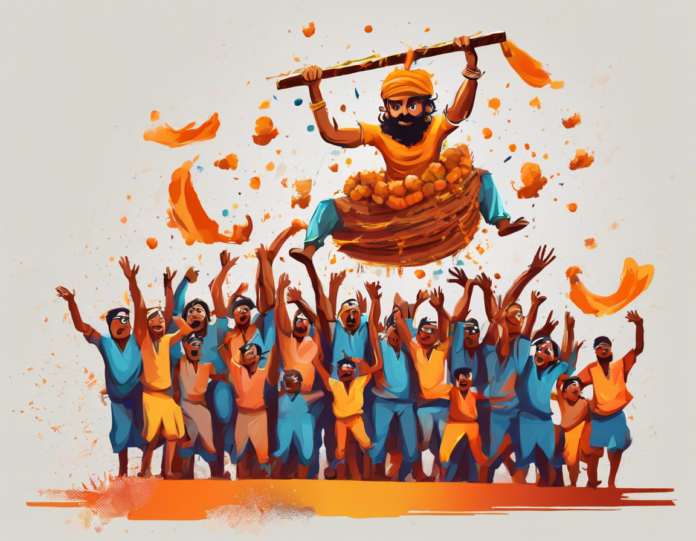Introduction
Dahi Handi is a popular Indian festival that is celebrated with great fervor across the country, especially in the state of Maharashtra. It is a part of the Krishna Janmashtami celebrations and involves the formation of human pyramids to break a pot filled with curd hanging at a height. The festival symbolizes the mischievous nature of Lord Krishna, who was fond of stealing butter as a child.
History and Significance
Dahi Handi has its roots in the legends of Lord Krishna, who would often steal butter from pots hung high up in houses. The festival is celebrated on the day after Janmashtami, which marks the birth of Lord Krishna. It is believed that Lord Krishna, along with his friends, used to form human pyramids to reach the pots of butter hanging from the ceilings of houses in his village.
Celebrations
Dahi Handi celebrations are grand and colorful affairs that bring communities together. In Maharashtra, especially in cities like Mumbai and Pune, hundreds of teams participate in forming human pyramids to break the handi (pot) filled with curd and other goodies. The pyramids can go as high as 9 tiers, with a young boy (often referred to as Govinda) climbing to the top to break the handi.
Preparations and Festivities
Preparations for Dahi Handi begin weeks in advance, with teams practicing their pyramid formations and strategies. The handis are filled with a mixture of curd, milk, butter, and water, along with coins and other prizes. The festivities start early in the morning, with teams moving from one location to another, trying their hand at breaking as many handis as possible.
Challenges and Safety Concerns
While Dahi Handi is a joyous occasion, it also comes with its share of challenges and safety concerns. The formation of human pyramids, especially when they go several tiers high, can be risky and lead to accidents. In recent years, there have been calls to make the celebrations safer by imposing height restrictions on the pyramids and ensuring that safety guidelines are followed.
Traditional Practices and Customs
Along with forming human pyramids, Dahi Handi celebrations also include other traditional practices and customs. Women sing folk songs and perform traditional dances like lezim to cheer on the participants. Prayers are offered to Lord Krishna for prosperity and good fortune. Special sweets and dishes like shrikhand, puran poli, and modak are prepared as offerings.
Modern-Day Trends and Innovations
In recent years, Dahi Handi celebrations have taken on a more competitive and commercial tone. Teams compete for cash prizes and sponsorships, and the festivities are often accompanied by music, dance performances, and celebrity appearances. Some groups even use cranes to hang the handis at greater heights, adding a new twist to the traditional event.
Environmental Impact and Sustainability
As Dahi Handi involves the use of earthen pots, curd, and other natural materials, it is considered to be an eco-friendly festival. However, in recent years, there has been a growing concern about the waste generated during the celebrations. Steps are being taken to promote the use of biodegradable materials and reduce the environmental impact of the festival.
FAQs (Frequently Asked Questions)
-
What is the significance of Dahi Handi?
Dahi Handi is a festival that celebrates the mischievous nature of Lord Krishna, who would steal butter as a child. It symbolizes unity, teamwork, and overcoming obstacles. -
How is Dahi Handi celebrated?
Dahi Handi is celebrated by forming human pyramids to break a pot filled with curd hanging at a height. Teams compete to break as many handis as possible and win prizes. -
Is Dahi Handi a religious festival?
Yes, Dahi Handi is a religious festival that is celebrated as part of the Krishna Janmashtami festivities. It honors the birth of Lord Krishna and his playful antics as a child. -
Are there any age restrictions for participating in Dahi Handi?
There are no specific age restrictions for participating in Dahi Handi, but children are often discouraged from climbing to the top of the pyramids due to safety concerns. -
How can one participate in Dahi Handi celebrations?
To participate in Dahi Handi celebrations, one can join a local team or group that is organizing the event. It is advisable to practice the pyramid formations and safety guidelines beforehand. -
What are some traditional dishes prepared during Dahi Handi?
Traditional dishes prepared during Dahi Handi include shrikhand (sweet yogurt dessert), puran poli (sweet flatbread), and modak (steamed dumplings). -
Is Dahi Handi celebrated only in Maharashtra?
While Dahi Handi is most popular in Maharashtra, it is also celebrated in other parts of India, especially in states with a significant Krishna devotee population like Gujarat and Rajasthan. -
Why are height restrictions imposed on Dahi Handi pyramids?
Height restrictions are imposed on Dahi Handi pyramids to ensure the safety of participants. Climbing to great heights can lead to accidents and injuries, and the restrictions are meant to prevent such incidents. -
How can one contribute to making Dahi Handi celebrations more sustainable?
To make Dahi Handi celebrations more sustainable, one can use eco-friendly materials like biodegradable pots and organic ingredients. Avoiding excessive waste generation and promoting recycling are also important steps. -
What are some safety tips for participating in Dahi Handi celebrations?
Some safety tips for participating in Dahi Handi celebrations include wearing proper footwear, staying hydrated, following the instructions of team leaders, and being cautious while climbing the pyramids. It is also important to have first aid kits and emergency contact numbers handy.















